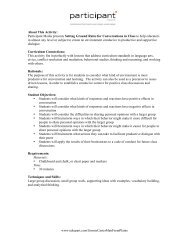THE KITE RUNNER COMPANION CURRICULUM - TakePart
THE KITE RUNNER COMPANION CURRICULUM - TakePart
THE KITE RUNNER COMPANION CURRICULUM - TakePart
Create successful ePaper yourself
Turn your PDF publications into a flip-book with our unique Google optimized e-Paper software.
HANDOUT 1.1<br />
INTRODUCTION TO AFGHANISTAN<br />
ETHNIC GROUPS<br />
OF AFGHANISTAN<br />
Afghanistan is an ethnically diverse country. Its inhabitants form a complex mosaic of<br />
ethnic and linguistic groups, a reflection of the country’s geographic location as well<br />
as its history of frequent external occupiers. As of July 2007, there are approximately<br />
32 million people estimated to live in Afghanistan. Pashtu and Dari are considered<br />
the official languages of Afghanistan, and are spoken by 85% of the people. Thirty<br />
other minor languages are also spoken in Afghanistan, representing the last 4% of<br />
the population. There is also a large degree of bilingualism amongst the inhabitants<br />
of the country. About 99% of the population is Muslim, and of these Muslims, 84%<br />
belong to the Sunni sect. There has been a long history of an ethnic hierarchy within<br />
Afghanistan. It has created imbalances in wealth, influence and education within its<br />
society. Traditionally, Pashtuns have dominated the country because they are the<br />
presumed majority of the population. As a result, many of the other ethnic groups<br />
have not had a strong voice within the society. The ethnic groups in Afghanistan do<br />
not form a concrete caste system like India. But, the society does have a firm and<br />
structured hierarchy which dominates the inter-ethnic interactions and relations.<br />
PASHTUNS<br />
TAJIKS<br />
HAZARAS<br />
• Pashtuns are the majority ethnic group in Afghanistan, about 42% thereby<br />
constituting just under half of the population<br />
• They are the highest ethnicity on the social ladder and dominate governmental<br />
bodies<br />
• Pashtu is their native language<br />
• They consist mainly of Sunni Muslims<br />
• Tajiks account for about 27% of the population of Afghanistan<br />
• They are the second largest ethnic community within Afghanistan<br />
• They are identified with agriculture and town life<br />
• They mainly inhabit the fertile eastern valleys<br />
• They are a group that is considered to have low income and like many Hazaras,<br />
they are not the highest on the social ladder. However, there Tajiks that are<br />
successful and important members of the government<br />
• Large numbers of Tajiks are city dwellers as well<br />
• The Hazara ethnic group resides mainly in the central Afghanistan mountain<br />
region called ‘Hazarajat’<br />
• They make up approximately 9% of Afghanistan’s population<br />
• There are also significant populations of Hazaras in Pakistan and Iran<br />
• Historically, the Hazara seem to have Mongolian origins, as evidenced by physical<br />
attributes and parts of the culture and language<br />
• It is commonly believed that the Hazara are descendants of Genghis Khan’s<br />
army, which marched into the area during the 12th century. Proponents of this<br />
view hold that many of the Mongol soldiers and their family members settled<br />
in the area and remained there after the Mongol empire dissolved in the<br />
13th century, converting to Islam and adopting local customs<br />
14<br />
APPENDIX 1









